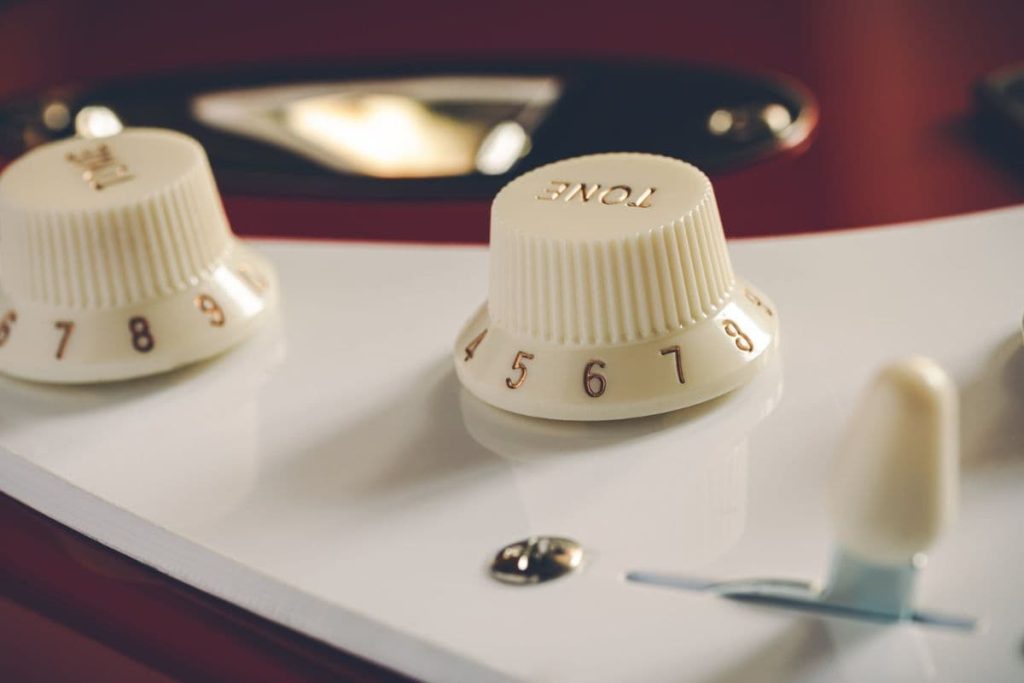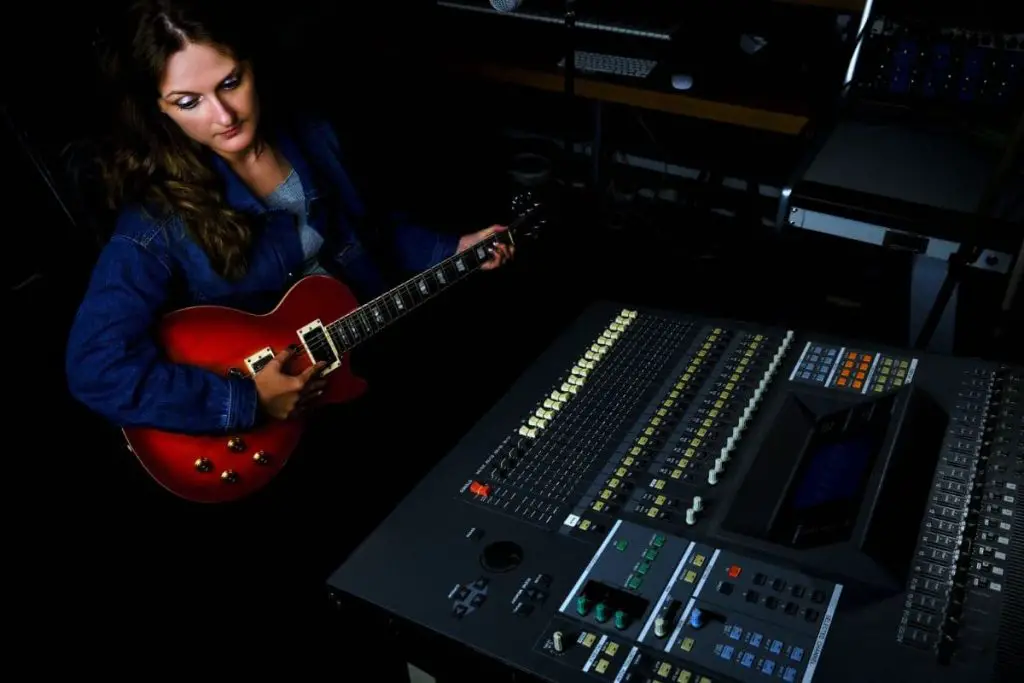One of the most common problems guitarists face, especially during their early days, is muffled or muddy sound. This problem can often be highly frustrating, especially when a guitarist can’t pinpoint its reason. Thankfully, the problem is easily solvable with a bit of effort, so you can quickly go from having a muffled-sounding guitar to one that sounds as clear and bright as you want.
If your guitar sounds muffled, you probably have to change your fretting and strumming technique. Your fingers are probably not placed correctly, and you’re not pressing hard enough to achieve a clean sound. It’s also possible that your tone is not set up correctly on your guitar and amp.
If you’re suffering from a muddy, muffled guitar tone, there are several solutions for you to use to get your axe back to its true sounds. After all, a muffled sound will not deliver the signature peaks and valleys of sound that the guitar is best at producing. This article will explore what you should do if you want a clear-sounding guitar tone during practice and on recordings.
If you want to find out what my recommended guitar gear is, then here is what I recommend on Amazon:
- Fender Cutaway Acoustic-Electric Guitar Bundle (MY FAVORITE GUITAR)
- Snark SN-8 Super Tight All Instrument Tuner (Easiest Tuner I’ve Used)
- 6 String Acoustic Guitar Capo (Best CAPO for quick changes)
- Dunlop Max Grip 1.0mm Nylon Picks (Thick Guitar Pick So You Don’t Lose Grip!)
- Universal Guitar Stand (Cheap & Minimalist Guitar Stand I Recommend)
- Levy’s 2″ Wide Quick Adjust Guitar Strap (Best Guitar Strap For Any Level)

What To Do When Your Electric Guitar Sounds Muffled
1. You’ll Have To Work on Your Fretting Technique
One of the most common reasons a guitar might not sound loud or clear enough is that the guitarist’s fretting hand is not strong and skillful enough. While the correct fretting technique is not exactly rocket science, it takes a lot of practice to get it right.
Let’s examine the possible mistakes and see what you can do to fix them.
You Don’t Apply Enough Pressure on the Strings
One likely reason your guitar sounds somewhat off is that you’re not applying enough pressure on the strings. This issue often happens to beginner players who have not developed enough strength in their fretting hands or have difficulty maintaining that position without pain or cramps.
If your hand is not strong enough, you must apply more pressure on the strings when playing consciously. This technique will be challenging at first, but as you develop strength over time, it will become progressively easier. After a while, you won’t even have to think about it, and you’ll apply enough pressure automatically.
It would be best if you spent time practicing your fretting hand strength. This exercise is essential if you’ve only just started playing guitar, but if you feel you don’t have enough strength might benefit from this.
A great way to strengthen your fretting hand is to play major scales every day while focusing hard on strength. As you progress, you can increase your speed to make sure that you can maintain stability at higher tempos.
There is also a technical aspect when it comes to this. You must pay attention to how you hold your guitar’s neck when playing. Support the neck with the thumb of your fretting hand while you play. This support will make it much easier for you to apply enough pressure on the strings.
It’s also important not to press the strings too hard. That can also create a muffled sound, so it’s counterproductive. However, that’s not a very common problem, so it most likely won’t affect you.
You Don’t Place Your Fingers Correctly on the Strings
Another essential thing to note is correct finger placement. Your fingers should be in front of the fret you’re playing, not directly on it or far away. You probably already know this, but if your guitar sounds muffled, you may not be using this knowledge.
In other words, you may ignore where your fingers land, so you accidentally press the string where you shouldn’t. Slow down and monitor your fretting hand to check if this is the case. Adjust if necessary and focus on getting this right before returning to normal tempos.

It might also be possible that you don’t press the strings with the very tip of your fingers. If you’ve got the habit of doing this, it’s straightforward to hold two strings simultaneously without noticing. This method will muffle the sound of the string you’re accidentally holding, ruining the sound of the entire chord.
To check if you do this, you can hold a chord, for example, D major, and strum each string individually to see if they all sound good. If one of the strings sounds muffled, correct your finger placement. Pay attention to this and slow down your playing until you lose this habit.
2. Examine Your Strumming Technique
Not using the correct strumming technique can also lead to a muffled guitar sound. While this is not such a significant influence as your fretting technique, it can lead to problems and make your guitar sound worse than it could.
Strumming strength is something you should be aware of when playing. Sometimes, guitarists strum too forcefully, which ruins the sound and makes the guitar sound muddy. When strumming too hard, it’s easy to include the strings you’re not supposed to, which creates a lot of noise.
On the other hand, strumming without enough energy is also wrong. It will make your guitar sound too quiet, which can, in turn, make it sound muffled. Doing this can also lead to not getting all the strings you should when strumming, so you’ll end up without some notes in your chords.
You should find a sweet spot between being too aggressive and loud and being too soft. It might take some time, but you’ll reap the benefits after a while. Practice hard enough, and you’ll quickly get to a satisfying guitar tone.
3. Pay Attention to Your Tone Knobs
If your fretting and strumming technique is on point, but your guitar still sounds muffled or muddy, the cause of the problem might be more evident. Many guitarists have been on the verge of breakdown before realizing they had forgotten they had turned down the tone knobs.
A tone knob controls a potentiometer that acts as a low-pass filter. A low pass filter doesn’t allow frequencies below a certain threshold to pass through, which is how you control your tone. The more it’s turned down, the mellower it sounds. The more it’s turned up, the brighter and crisper your playing will sound.
If turned down too far, it may limit too many bass frequencies from passing through, making your tone too mellow and thus muddy. While turning down the tone knob(s) might be desirable in some music genres, you might get a muffled tone that won’t sound good if you turn it down too much.
If your guitar sounds muffled, play with the tone knobs and see what happens. Turning them up a notch might make your sound clear enough to be good while not sounding too bright. This tip is generally good advice whenever you’re experiencing sound problems. Before you lose your temper, check the tone knobs and see if turning them does anything.

Check Your Amp and Pedals
If the tone knobs on your guitar seem to be entirely in order, it’s good to check the EQ on your amp and pedals. It’s possible that something there is causing the trouble. If you’re a pedal aficionado, the easiest way is to turn off all your pedals and focus solely on your amp.
The treble and presence knobs on your amp often cause problems. They control the high frequencies, and if you turn them down too low, they may create quite a muddy sound. Turn up those knobs to make the sound brighter.
If everything is alright with your amp, you can inspect your pedals one by one until you find the one causing the problem. Play around with the knobs and see what changes they make. Remember the settings for when you play in the future, so you don’t have to repeat the process.
4. Check Your Strings
Old and overused strings will do wonders for your tone if your goal is to have a dead, muffled tone. If you want a bright and clear tone, changing your strings regularly and making sure they’re not dirty is an excellent place to start.
You don’t have to change your strings as soon as you encounter sound problems. They may be dirty, so you need to clean them. When you play, oils, sweat, pieces of skin, and other nasty things end up on your strings. Letting this gunk accumulate on your strings will muffle your sound, and no matter what you do to your guitar, it won’t sound clear.

If your strings are dirty, wiping them thoroughly with a clean piece of cotton cloth will most likely do the trick. It would be best if you made a habit of cleaning your strings after every practice session. You’ll be surprised to see how much dirt calls your strings home, especially if you haven’t wiped them in a while (or ever).
However, if you’ve had the same strings for ages, it’s time to change them. Yes, an old piece of advice says you can boil your strings to freshen them up, but this is not a long-term solution, and it’s not even a good one. Don’t be cheap—get a fresh set of strings, and you will achieve a great guitar tone along with the purchase.
5. Use a Reasonable Tuning To Counter Muffled Sound
If you like playing ultra brutal death metal, you’re probably a fan of low guitar tunings. While these tunings sound great when pulled off right, not every guitar is suitable for this. You might push your guitar a bit too much, which doesn’t make it sound good.
You’ve probably noticed that in the super heavy genres of metal, guitarists often use guitars with seven, eight, or even more strings in some rare cases. This choice is not just for cool points. Luthiers created these guitars to be tuned lower than standard guitars.
This design doesn’t just refer to how they build their necks— but also to the pickups you should use on these guitars.
Such guitars have pickups designed for guitarists to use on heavy down-tuned guitars and can handle that sort of pressure well. If you have a regular six-string guitar and try to tune it to drop B, it will probably sound muffled, and you won’t get a satisfying tone.
If you want to tune your guitar as low as possible, you can get a guitar made for that or upgrade the pickups. The latter option is probably cheaper, but it’s not always possible for you to install such pickups.
If neither choice is available to you, you can, of course, down-tune the guitar you already have, but don’t push it too much. Find a tuning that’s low and brutal enough but still allows you to have a somewhat clear tone, which is neither muffled nor muddy.
6. How To Prevent a Guitar From Sounding Muffled in a Mix
You may have made your guitar sound great when you play it during practice sessions or when you jam with friends. However, having a clear tone in those contexts doesn’t always mean you’ll have a great tone when recording. You can quickly get a muffled sound when you record your guitar, even if it sounds alright generally.

This issue requires additional steps and practice, but you should grasp it quickly. Let’s see what you can do if your guitar sounds muffled while recording songs.
Reduce the Low End
Too many deep sounds can make your guitar muffled in a mix, especially if there’s a strong bass guitar presence. Since you don’t need two instruments that produce deep frequencies, you might want to cut some of those low frequencies from your guitar to make room for the bass to shine, making both the guitar and the whole mix clearer.
The best way to use this is to:
- Apply a high-pass filter with a moderate slope.
- Cut around 80 to 100 Hz to remove the rumbling low-end sounds and thus make everything clearer.
You should not use a high-pass filter with a steep slow. This process might make the sound unnatural and create a disconnect from the guitar and the other instruments in the mix.
Utilize Multi-Band Processing
If you want to tame the harshness of your top end without losing the clarity of your bottom end, broadband processing won’t be enough. Instead, it would be best if you opt for multi-band processing, which will allow you to have a top end that is not harsh, and a low end that doesn’t lose clarity, making for a clearer guitar sound.
You can adopt this system by following these steps:
- You’ll have to duplicate your guitar track and apply an instance of a multi-band processor on each track. The low end’s cutoff frequency on both tracks should be around 300 HZ. The threshold level should be zero, so there’s no loss in the gain.
- After that, you should solo the low end on one track and mute it on the other. This method allows you to process frequencies above 300 Hz while leaving everything below that cutoff untouched. Using this trick while mixing will help you keep your guitar sound clear.
Be Careful When Layering Your Guitars
Guitars are often layered until the mixing engineer gets a wall of sound. This process can deliver amazing effects, but it can also be a muffled mess, depending on how you go about it.
Layering different guitars that dominate the same frequencies will quickly become a mess. Instead, use guitars that dominate different frequencies. For example, you can start with a heavy guitar on the low end, then add a guitar that captures the higher tones to get a full sound.
A wall of low-end noise will sound neither heavy nor good in a mix. That could only work in noise music, but you’re probably not going for that.
If you don’t have different guitars to pull this off, plug your guitar directly into your audio interface and use different virtual amps to get different sound effects. Use a heavy, distorted amp for one guitar track and a brighter amp for the other track.
Apply a Glue Compressor
Once you’ve recorded your guitar tracks and layered them, it’s a good idea to apply a glue compressor to your tracks to make them tighter. A glue compressor’s job is to compress all the tracks instead of just one. This “glues” them together and makes them feel like one.
While a glue compressor won’t do much in terms of muffled sound, it will make your guitar tracks sit tighter together and sound less sloppy. This process will increase your overall sound quality and make your entire track seem much more professional.
Final Thoughts On What To Do When Your Electric Guitar Sounds Muffled
The first thing you should address if your guitar sounds muffled is your technique. Make sure your fretting and strumming are on point. If your technique is good, but your sound is still muddy—look at your guitar’s tone knobs and play with them to see what happens.
You should also take good care of your guitar—ensure your strings are fresh and clean, as that will significantly impact the sound. You should also avoid tuning your guitar too low if it isn’t suited to super-low tunings. Good luck with your guitar playing!
If you want to find out what my recommended guitar gear is, then here is what I recommend on Amazon:
- Fender Cutaway Acoustic-Electric Guitar Bundle (MY FAVORITE GUITAR)
- Snark SN-8 Super Tight All Instrument Tuner (Easiest Tuner I’ve Used)
- 6 String Acoustic Guitar Capo (Best CAPO for quick changes)
- Dunlop Max Grip 1.0mm Nylon Picks (Thick Guitar Pick So You Don’t Lose Grip!)
- Universal Guitar Stand (Cheap & Minimalist Guitar Stand I Recommend)
- Levy’s 2″ Wide Quick Adjust Guitar Strap (Best Guitar Strap For Any Level)
Related Posts:

